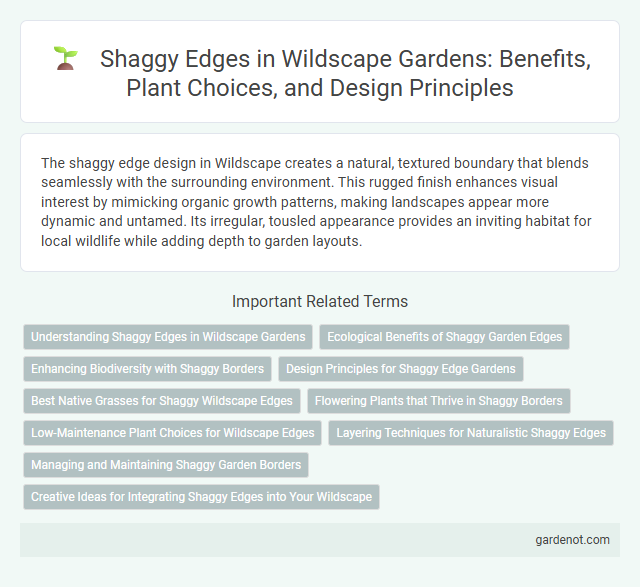The shaggy edge design in Wildscape creates a natural, textured boundary that blends seamlessly with the surrounding environment. This rugged finish enhances visual interest by mimicking organic growth patterns, making landscapes appear more dynamic and untamed. Its irregular, tousled appearance provides an inviting habitat for local wildlife while adding depth to garden layouts.
Understanding Shaggy Edges in Wildscape Gardens
Shaggy edges in Wildscape gardens refer to irregular, textured borders created by naturalistic planting designs that blend native grasses and wildflowers. These edges enhance biodiversity by providing habitat for pollinators, birds, and small mammals while promoting soil health through diverse root systems. Emphasizing shaggy edges supports ecological balance and aesthetic appeal, making them a key feature in sustainable garden planning.
Ecological Benefits of Shaggy Garden Edges
Shaggy garden edges provide vital habitats that support biodiversity by offering shelter and food sources for pollinators, insects, and small wildlife. These edges enhance soil health through natural decomposition processes and promote water retention, reducing erosion and runoff. Integrating shaggy edges within wildscapes contributes to resilient ecosystems and supports sustainable garden management practices.
Enhancing Biodiversity with Shaggy Borders
Shaggy edges create diverse microhabitats that support a wide range of flora and fauna, enhancing biodiversity in wildscapes. These shaggy borders provide shelter and breeding grounds for insects, birds, and small mammals, contributing to a balanced ecosystem. Integrating shaggy edges into landscape design promotes ecological connectivity and resilience, crucial for sustaining native species populations.
Design Principles for Shaggy Edge Gardens
Shaggy Edge gardens emphasize naturalistic design principles that mimic wild, untamed landscapes by incorporating layered vegetation with varied textures and native plants to promote biodiversity. Utilizing irregular, organic shapes for pathways and planting beds creates a sense of spontaneity, encouraging wildlife habitats and ecological balance. Strategic placement of hardy, drought-resistant species ensures sustainability while maintaining the garden's rugged aesthetic.
Best Native Grasses for Shaggy Wildscape Edges
Shaggy wildscape edges thrive with native grasses such as Little Bluestem (Schizachyrium scoparium), Switchgrass (Panicum virgatum), and Indian Grass (Sorghastrum nutans) for natural, low-maintenance borders. These species provide dense, textured foliage and support local ecosystems by attracting pollinators and wildlife. Selecting native grasses adapted to regional conditions enhances soil health and preserves biodiversity in shaggy wildscape edges.
Flowering Plants that Thrive in Shaggy Borders
Shaggy edges in Wildscape habitats support diverse flowering plants such as coneflowers, bee balm, and black-eyed Susans, which thrive in their semi-wild, textured borders. These plants attract pollinators like bees and butterflies, enhancing biodiversity and promoting ecosystem health. Their robust growth and vibrant blooms create natural, sustainable barriers that require minimal maintenance.
Low-Maintenance Plant Choices for Wildscape Edges
Shaggy edge areas in wildscapes benefit from low-maintenance plants like native grasses, sedges, and drought-tolerant perennials that thrive with minimal care. Species such as Blue Fescue (Festuca glauca), Prairie Dropseed (Sporobolus heterolepis), and Purple Coneflower (Echinacea purpurea) provide erosion control while enhancing habitat diversity. These resilient plants support local wildlife and reduce upkeep through their natural adaptation to regional soil and climate conditions.
Layering Techniques for Naturalistic Shaggy Edges
Shaggy edge layering techniques emphasize varied hair lengths and textured cuts to create a natural, tousled appearance in Wildscape designs. Utilizing strategic layering angles enhances depth and movement, mimicking organic irregularities found in natural landscapes. Incorporating lightweight thinning methods prevents bulk, promoting a seamless blend that replicates the wild, unrefined aesthetic.
Managing and Maintaining Shaggy Garden Borders
Shaggy edges on garden borders create natural, textured boundaries that require regular trimming and selective pruning to maintain their wild aesthetic without becoming overgrown. Managing these areas involves strategically removing invasive weeds and dead plant material to promote healthy growth and enhance biodiversity. Maintaining a balance between structured care and allowing natural growth supports a thriving ecosystem within the wildscape garden borders.
Creative Ideas for Integrating Shaggy Edges into Your Wildscape
Incorporate shaggy edges into your wildscape by layering native grasses and wildflowers to create natural, textured borders that enhance biodiversity and provide habitat for pollinators. Use irregular, uneven lines to mimic natural landscapes, promoting a seamless transition between cultivated spaces and wild areas. Integrating rock clusters or logs along the shaggy edge further supports wildlife shelter while adding visual interest and structural diversity to your wildscape design.
Shaggy edge Infographic

 gardenot.com
gardenot.com